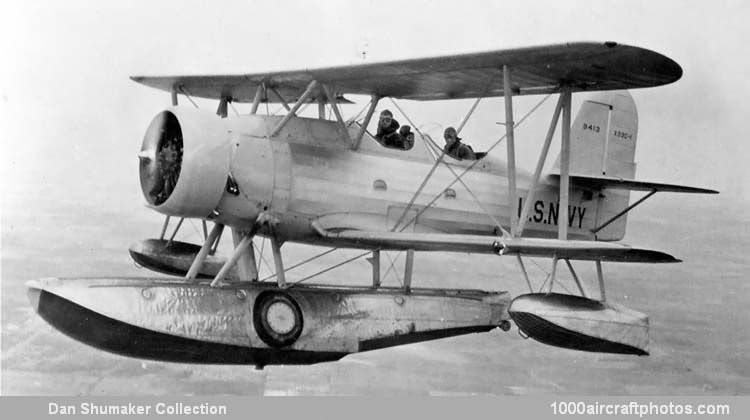The primary mission for the SOC, ordered in prototype form on June 19, 1933, as the XO3C-1, was scout-observation from battleships and cruisers. This required the aircraft to be a floatplane, catapulted for take off and recovered by winch after alighting on the sea alongside the parent ship. The XO3C-1 had folding wings with full-span slots and flaps on the top wing, and a fully enclosed cockpit for the pilot and gunner.
Armament consisted of a fixed forward-firing 0.30 in (7.62 mm) machine gun in the wing and a 0.30 in (7.62 mm) machine gun in the rear cockpit that was given a clear field of fire by retracting the fuselage turtle deck behind the cockpit. Additionally two 325 lb (147 kg) bombs could be carried.
As first flown with BuNo. 9413 in April 1934, the XO3C-1 had an amphibious landing gear, with twin wheels incorporated in the central main float. This feature was later abandoned, and the production model was a plain seaplane with alternative wheel landing gear for land operation.
After successful evaluation in competition with the Douglas XO2D-1 and Vought XO5U-1, the Curtiss biplane was put into production as the SOC-1. The change in designation followed the combination in 1934 of the scouting and observation roles; previously, observation types had been deployed on battleships, and scouting types were attached to cruisers, hence the XO3C-1 was redesignated XSOC-1 in 1935. It was eventually lost when it crashed at NAS Jacksonville in June 1941.
The SOC-1 had a 600 hp Pratt & Whitney R-1340-18 Wasp nine-cylinder air-cooled radial engine, and deliveries began on November 12, 1935. Production totaled 135 (BuNos. 9856 to 9990), followed by 40 land-based SOC-2s (BuNos. 0386 to 0425) with minor improvements and R-1340-22 engines, and 83 SOC-3s (BuNos. 1064 to 1146) which were like the SOC-2s but had the interchangeable alighting gear. Aircraft equipped with arrester gear for carrier operations were designated SOC-2A and SOC-3A after modification in 1942.
To comply with an USN policy to manufacture 10% of its own Service aircraft, 44 Seagulls (BuNos. 1147 to 1190) were ordered from the Naval Aircraft Factory, Philadelphia, Pennsylvania. Equivalent to the SOC-3, they were designated SON-1, and SON-1A with arrester gear. Three final Seagulls built by Curtiss were designated SOC-4 to serve with the USCG (s/n V171 to V173); these were acquired by the USN in 1942 and modified to SOC-3A standard under the BuNos. 48243 to 48245.
Production of the SOC Seagull series ended in the spring of 1938, by which time work had begun on a monoplane scout intended as a replacement. However, the newer aircraft, the Curtiss SO3C, had a somewhat unsatisfactory operational career and was withdrawn from service early in 1944. All remaining SOC biplanes were hastily restored to operational status and continued in service until the end of the war. When they were finally retired, they ended an era of Naval aviation, for no other types were produced to replace them aboard the battleships and cruisers of the fleet."
Span: 36 ft 0 in (10.97 m)
Length: 31 ft 5 in (9.58 m)
Height: 14 ft 9 in (4.50 m)
Wing area: 342 sq.ft (31.77 sq.m)
Weight empty: 3,788 lb (1,718 kg)
Loaded weight: 5,437 lb (2,466 kg)
Max speed: 165 mph (266 kmh) at 5,000 ft (1,524 m)
Cruise speed: 133 mph (214 kmh)
Climb: 880 ft (268 m)/min
Service ceiling: 14,900 ft (4,542 m)
Range: 675 mls (1,086 km)
